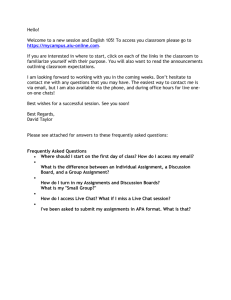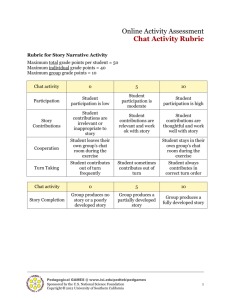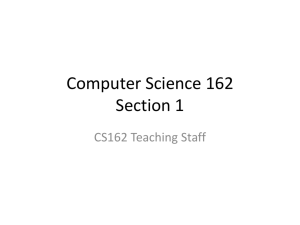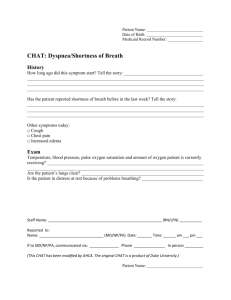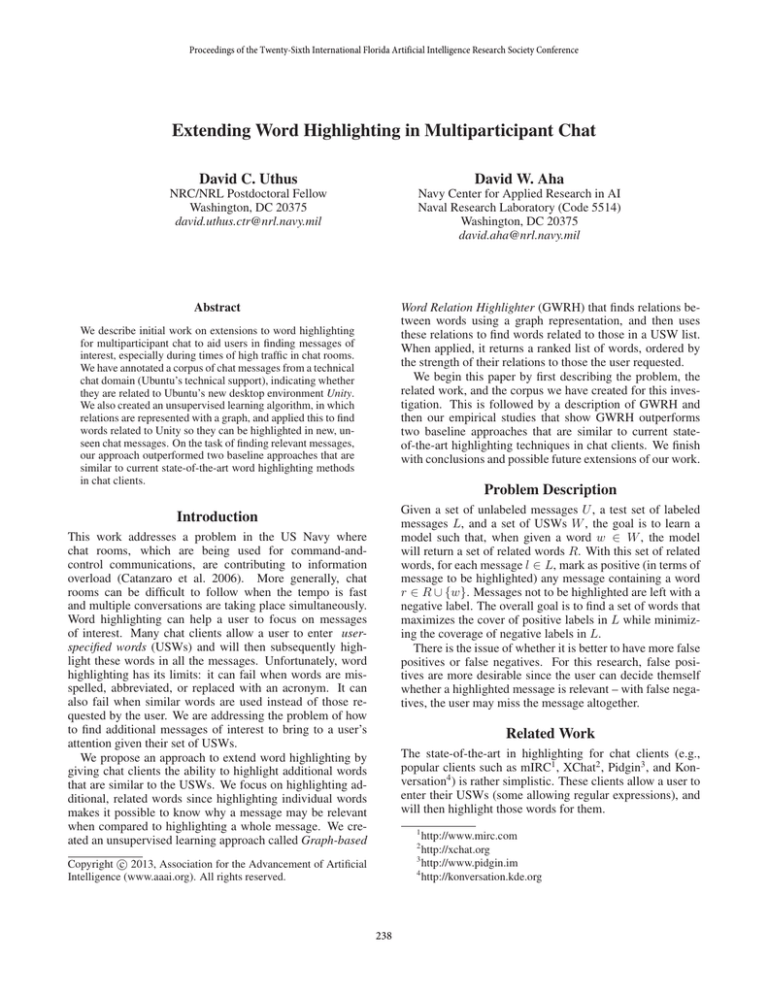
Proceedings of the Twenty-Sixth International Florida Artificial Intelligence Research Society Conference
Extending Word Highlighting in Multiparticipant Chat
David W. Aha
David C. Uthus
Navy Center for Applied Research in AI
Naval Research Laboratory (Code 5514)
Washington, DC 20375
david.aha@nrl.navy.mil
NRC/NRL Postdoctoral Fellow
Washington, DC 20375
david.uthus.ctr@nrl.navy.mil
Abstract
Word Relation Highlighter (GWRH) that finds relations between words using a graph representation, and then uses
these relations to find words related to those in a USW list.
When applied, it returns a ranked list of words, ordered by
the strength of their relations to those the user requested.
We begin this paper by first describing the problem, the
related work, and the corpus we have created for this investigation. This is followed by a description of GWRH and
then our empirical studies that show GWRH outperforms
two baseline approaches that are similar to current stateof-the-art highlighting techniques in chat clients. We finish
with conclusions and possible future extensions of our work.
We describe initial work on extensions to word highlighting
for multiparticipant chat to aid users in finding messages of
interest, especially during times of high traffic in chat rooms.
We have annotated a corpus of chat messages from a technical
chat domain (Ubuntu’s technical support), indicating whether
they are related to Ubuntu’s new desktop environment Unity.
We also created an unsupervised learning algorithm, in which
relations are represented with a graph, and applied this to find
words related to Unity so they can be highlighted in new, unseen chat messages. On the task of finding relevant messages,
our approach outperformed two baseline approaches that are
similar to current state-of-the-art word highlighting methods
in chat clients.
Problem Description
Given a set of unlabeled messages U , a test set of labeled
messages L, and a set of USWs W , the goal is to learn a
model such that, when given a word w ∈ W , the model
will return a set of related words R. With this set of related
words, for each message l ∈ L, mark as positive (in terms of
message to be highlighted) any message containing a word
r ∈ R ∪ {w}. Messages not to be highlighted are left with a
negative label. The overall goal is to find a set of words that
maximizes the cover of positive labels in L while minimizing the coverage of negative labels in L.
There is the issue of whether it is better to have more false
positives or false negatives. For this research, false positives are more desirable since the user can decide themself
whether a highlighted message is relevant – with false negatives, the user may miss the message altogether.
Introduction
This work addresses a problem in the US Navy where
chat rooms, which are being used for command-andcontrol communications, are contributing to information
overload (Catanzaro et al. 2006). More generally, chat
rooms can be difficult to follow when the tempo is fast
and multiple conversations are taking place simultaneously.
Word highlighting can help a user to focus on messages
of interest. Many chat clients allow a user to enter userspecified words (USWs) and will then subsequently highlight these words in all the messages. Unfortunately, word
highlighting has its limits: it can fail when words are misspelled, abbreviated, or replaced with an acronym. It can
also fail when similar words are used instead of those requested by the user. We are addressing the problem of how
to find additional messages of interest to bring to a user’s
attention given their set of USWs.
We propose an approach to extend word highlighting by
giving chat clients the ability to highlight additional words
that are similar to the USWs. We focus on highlighting additional, related words since highlighting individual words
makes it possible to know why a message may be relevant
when compared to highlighting a whole message. We created an unsupervised learning approach called Graph-based
Related Work
The state-of-the-art in highlighting for chat clients (e.g.,
popular clients such as mIRC1 , XChat2 , Pidgin3 , and Konversation4 ) is rather simplistic. These clients allow a user to
enter their USWs (some allowing regular expressions), and
will then highlight those words for them.
1
http://www.mirc.com
http://xchat.org
3
http://www.pidgin.im
4
http://konversation.kde.org
2
c 2013, Association for the Advancement of Artificial
Copyright Intelligence (www.aaai.org). All rights reserved.
238
[01:24] <bible-boy> anything else like unity
that i can use on 11.04
[01:24] <bible-boy> cause i like unity
[01:24] <TomRone> bible-boy, install fluxbox
desktop environment with synaptic and give
that a shot or lxde perhaps. you use the
login manager to choose which environment to
use
[01:25] <lapion> bible-boy, why can’t you
use unity ?
[01:25] <bible-boy> where can i download
that because i have it installed on a pc
without internet. Right now im running
Ubutnu off a live cd
[01:25] <bible-boy> oh i cant use it because
i only have 512mb memory
[05:40] <daddy> is there a way to change
11.04 interface back to 10.10
[05:40] <DrFrankenstein> daddy: launching
programs from a drop down menu instead of
the screen with the icons?
[05:40] <Soupermanito> yes, log out and
choose clasic interface at the log in menu
Figure 1: Example chat conversation where the users are
discussing about Unity through inference (Unity is the 11.04
default interface).
One related research area concerns the topic detection and
tracking of chat messages, specifically applications of unsupervised learners (Bingham, Kabán, and Girolami 2003;
Kolenda, Hansen, and Larsen 2001). The difference between these approaches and what we are investigating here is
that these approaches are topic-focused – they group words
only within a set of topics whereas we instead find relations independent of topics. For example, Bingham, Kabán,
and Girolami required the number of topics to be estimated,
which limits the granularity of the topic groups. Kolenda,
Hansen, and Larsen also had a set number of topics and a
reject group, where messages not fitting in the set topics
would be put in this latter group. For the problem we are
investigating, these approaches would be useful when a user
is interested in a word that can be found in one of these topics, but would fail should a user be interested in a word not
grouped under one of these topics. Additionally, for these
approaches, the strength of a word is in relation to a topic,
while we are interested in strengths of relationships between
words.
Another area of related work are approaches for finding
messages of relevance, particularly from a military perspective (Berube et al. 2007; Budlong, Walter, and Yilmazel
2009; Dela Rosa and Ellen 2009). All three of these approaches required prior knowledge to determine what is important: Berube et al. used regular expressions and entity
classes; Budlong, Walter, and Yilmazel used a rule-based algorithm and a statistical analysis approach using maximum
entropy; and Dela Rosa and Ellen used supervised learning
algorithms. New types of important messages would not be
detectable without new regular expressions, rules, or labeled
data. This differs from our goal of an approach that can
adapt as new types of messages are created.
Figure 2: Example chat conversation showing how a conversation can shift in topic. It began with Unity, but branched
to also discuss a different desktop environment. Red highlighted messages are messages about Unity.
USW, “Unity5 ,” since this was a hot topic following the release of Ubuntu 11.04. The training set consists of 81,848
messages and the test set consists of 8675 messages, with
468 of these labeled as positive.
Labeling this data requires determining whether a message is related to a particular topic. This is difficult due to the
conversational (threaded) nature of the chat messages and
the inference that is usually drawn from knowledgeable chat
users about a specific topic. An example of this is shown
in Figure 1, where user daddy asks a question about Unity,
referring to it as the “11.04 interface.” For the corpus, we
labeled only those messages that concern topics related to
Unity – this then results in some conversation threads to only
be partially labeled as positive due to the changing of topics
within a conversation. An example of this can be seen in
Figure 2, where a part of the conversation shifts from Unity
to an alternate desktop environment.
Graph-based Word Relation Highlighter
Figure 3 shows GWRH’s general framework. It begins by
applying an unsupervised learning algorithm on U , which
results in graph G. This graph is then used to find R based on
the words in W . Given a message to be checked m, GWRH
will then highlight all words in m from W ∪ R, returning
m0 .
GWRH creates an undirected graph where each node represents a word from the corpus and the edges are the weights
(strength of relations) between words. More specifically, the
edges connect all pairs of words that appear together in a
message and the weights represent the number of times they
appear together.
Corpus
We have created a corpus for testing using a subset of chat
logs from the Ubuntu Chat Corpus (Uthus and Aha 2013).
This corpus is composed of two parts: a training set of seven
days of unlabeled chat messages, beginning from Ubuntu
11.04’s release date (28 April to 4 May 2012) and a test
set of hand-annotated messages taken from one day (5 May
2012), which took us three weeks to annotate. The annotated
messages have a binary label – whether they are related to a
specific set of USWs. As a starting point, we have a single
UpdateGraph
Procedure UpdateGraph describes how new messages are
applied to the graph to update edge weights. For each mes5
Unity was a new desktop environment introduced by Ubuntu:
http://unity.ubuntu.com
239
sW
W
S
U
Unsupervised
Learner
(UpdateGraph)
Graph G
Extractor
User’s
Chat Client
Related Words R,
W
(H
M ighl
es ig
sa hte
ge d
m )
0
Highlighter
GWRH
Message m
Unlabeled Data U
(from chat logs)
Chat Stream
Figure 3: GWRH’s general framework and how it interacts with a user’s chat client.
sage u ∈ U , it will change the weights of G based on the
words found in u. For normalization, all text is changed to
lower case. For preprocessing, all name mentions are removed when the first word of a message matches the name
of an author seen in the past 100 messages. This limit was
chosen arbitrarily. Should a message u contain words not
seen before, the algorithm will add new vertices to the graph.
Procedure Extractor(words W , graph G, filter λ)
// W is the set of USWs
R, Lw , Ln ← ∅
// reset ranked lists
for each word w ∈ W do
N ← neighbors(G,
w)
P
w ← n∈N ew,n : ew,n > λ
for each neighbor
n ∈ N do
P
n ← v∈neighbors(G,n) en,v : en,v > λ
Lw ← Lw ∪ {(ew,n /w , n)}
Ln ← Ln ∪ {(ew,n /n , n)}
sort(Lw )
// sort w’s ratios
sort(Ln )
// sort neighbor’s ratios
for each neighbor n ∈ N do
n avg rank ← 21 · (rank(Lw , n)+rank(Ln , n))
R ← R ∪ {n avg rank}
Procedure UpdateGraph(message u, graph G)
u0 ← normalize and preprocess(u)
uT ← tokenize and remove duplicates(u0 )
for each t ∈ uT do
if vertex vt 6∈ G then G ← G ∪ {vt }
P ← all pairs(uT )
for each pair p in P do
if edge ep ∈ G then
ep ← ep + 1 // update edge weight
else
G ← G ∪ {ep }
ep ← 1
return sort by average rank(R)
After creating Lw and Ln , Extractor sorts them to compute the rankings for each neighbor. Ties are broken by order
of insertion into the graph. It will then compute the average
rank, and at the end, return the set of related words sorted by
their average rank.
We create two rankings to filter out common words that
appear frequently (e.g., stop words and words that are common technical terms but not generally considered stop words
in traditional texts). Ranking by Lw will give us a list of
words that appear most frequently with w, while ranking by
Ln will give us a list of words that consider w to be of relevance to them. The latter list then helps filter out the list of
the former, since common words will have w ranked low on
their lists.
To illustrate how these rankings are calculated, we refer to Figure 4. Suppose the value of for the neighboring nodes are already calculated and w = 50. For each
neighboring node, Extractor will calculate two weight ratios, one with w and one with i∈{A,B,C,D} . This will result
return G
Extractor
Procedure Extractor describes how the set of related words
R (ranked by the strength of the relations) is extracted from
G given the set of USWs W . For each w ∈ W and each
neighbor n of w, Extractor first calculates two ratios: one is
the ratio of the edge between n, w and the summed weights
(w ) of edges connecting to w, and the other is the ratio of
the same edge and summed weights (n ) of edges connecting to n. These ratios (along with the associated neighbor’s
identity) are stored in two lists, Lw and Ln .
When calculating these weights, we only consider edges
that have at least a minimal weight limit of λ. This helps
reduce possible noise in the graph, especially of accidental
mentions between unrelated words.
240
A = 40
B = 200
A
B
5
Highlighting
Algorithm
Precision
Recall
F2 score
baselines
baselinet
GWRHλ=9
0.71
1.0
0.49
0.52
0.5
0.65
0.55
0.56
0.61
Table 1: Results of our baseline approaches and GWRH
when λ = 9.
20
Empirical Study
We conducted a set of experiments to evaluate GWRH by
comparing it to two baseline approaches that are similar to
the current state-of-the-art capabilities of most IRC clients
for word highlighting. One baseline approach checks to see
if w is a substring of a message l ∈ L (called baselines );
the other baseline approach checks if w matches a tokenized
word in l (called baselinet ). We hypothesize that GWRH
can achieve better recall and F2 scores than our baseline approaches.
For our experiments, we used the corpus described earlier
in this paper. All messages were normalized by changing all
characters to lower case. They were then tokenized using
the NLTK tokenizer (Loper and Bird 2002) (with exception
for baselines ). GWRH was applied such that it used the top
ten ranked words in R and “unity” (the use of top ten was
chosen arbitrarily, though in future work this can be tested
as a parameter). For metrics, we use standard precision and
recall, along with F2 , which puts greater emphasis on recall
than precision.
Table 1 shows the results of running these baseline approaches and GWRH with λ = 9. Comparing the two
baselines, searching for substrings decreases precision when
compared to matching string tokens due to the word “unity”
being a substring of common words like “community”,
while only gaining a small increase in recall. These approaches only achieved recalls of 50% and 52% respectively,
showing that there are many messages about Unity that do
not explicitly mention it. GWRH, compared to the two baselines, achieves higher recall and F2 scores, which provides
informal support for our hypothesis.
Examining how λ effects GWRH, we ran a series of tests
with increasing values of λ. Figure 5 shows the results of
these tests. As can be seen, increasing λ initially increases
recall and precision, then has a smaller impact as it grows
further in value. This can be attributed to λ reducing the
noise from rare mentions of unrelated words.
The top ten ranked terms when λ = 9 are gnome, classic,
2d, 3d, compiz, interface, launcher, plugin, bar, and desktop. Unsurprisingly, many of these words share strong relations to Unity, either changing to alternative or past desktops
(gnome, classic), synonyms for a desktop environment (interface), components of Unity (launcher, bar, desktop, plugin), software Unity is built on (compiz) or concern issues
people had running Unity on older hardware (2d, 3d). More
importantly, we can see that in these top ten words, common English words are removed despite their frequent appearance. This is desirable since it allows GWRH to return
words that have stronger relevance to the USWs and less rel-
w
10
15
C
D
C = 20
D = 80
Figure 4: An example graph to use for Procedure Extractor.
5 20 10 15
5
20 10 15
in Lw = { 50
, 50 , 50 , 50 } and Ln = { 40
, 200
, 20 , 80 } with
respect to the four neighbors. When sorted and ranked, A
would have ranks 4 & 3, B would have ranks 1 & 4, C would
have ranks 3 & 1, and D would have ranks 2 & 2, all with
respect to Lw and Ln . When these ranks are averaged and
sorted, the neighboring nodes would then be in order of {C,
D, B, A}.
Extractor is executed only when the user submits a new
set of W – it does not update R every time G is updated
with a new message m. We chose this design since it is not
desirable to change the related set of words without the user
knowing, nor do we want to bother the user every time G is
updated.
Highlighter
In regular use, the highlighter method would take in R and
W . It will make use of any words in R that the user would
want highlighted (e.g., allowing a user to pick which additional words to highlight). For each new message m that it
receives from the chat stream, it will check to see if there
are any words in m that match a word in R ∪ W , and if so,
highlight these words. It will then pass the message to the
user’s chat client.
For the empirical studies described next, after extracting
R, GWRH will iterate through L and mark as positive all
messages that contain at least one word r ∈ R∪W . With respect to R, it will be restricted so only the top ranked words
will be used, with more detail described in the subsequent
section. It will then evaluate the messages to check which
are correctly marked as positive and negative.
241
1
could be possible then to prune such edges over time, and
even remove vertices once they no longer have any edges.
Additionally, the approach needs to be modified so it can
“forget” relations since terminology changes with time.
Finally, these ideas of extending word highlighting will
be evaluated through human subject studies in a simulated
Navy environment. As mentioned earlier, our work addresses a problem in the US Navy of chat and information
overload. We hope that our results will show that extending word highlighting can assist Navy watchstanders with
finding messages of interest in a fast-paced environment.
0.8
0.6
0.4
Precision
Recall
F2 score
0.2
0
1
2
3
4
5
6
7
8
9
10
λ
Acknowledgments
Figure 5: Results for different values of λ (parameter to filter
out noise).
Thanks to NRL for funding this research. David Uthus performed this work while an NRC postdoctoral fellow located
at the Naval Research Laboratory. The views and opinions
contained in this paper are those of the authors and should
not be interpreted as representing the official views or policies, either expressed or implied, of NRL or the DoD.
evance to words not in the USW list.
Conclusion
We have presented a new approach to extend word highlighting in multiparticipant chat. GWRH can find word relations
using a graph-based unsupervised learning algorithm. Our
results show that, for one corpus (concerning technical support), it outperforms two baseline approaches that are similar
to current state-of-the-art chat client capabilities.
While GWRH increases recall for our task, there are
some types of messages that it would not easily be able to
find. One example is messages that use pronouns to refer
to Unity. Another is messages that use a misspelling that
forms another correctly-spelled word (e.g., “unify” instead
of “unity”).
In our future research, we will first try to extend the corpus, allowing for formal validation of our hypothesis. As it
took three weeks to validate the 8675 messages in our test
set, we would then expect it to take many months to annotate
enough messages to allow for cross-validation. To alleviate
this, we are investigating how to leverage crowd sourcing for
annotating chat messages. In addition to annotating a longer
series of messages in time, we will also obtain annotations
for additional topics (i.e., other than Unity).
One possible extension for GWRH is to consider conversation threads. We could use these to train the model. When
looking at Figure 3, the unlabeled data could be disentangled
using a thread disentanglement method (Elsner and Charniak 2010; Wang and Oard 2009) prior to being passed to the
unsupervised learner. Instead of changing weights by examining only a single message in a vacuum, we could change
the weights by examining the message in context to its given
conversation. As a part of thread disentanglement, we will
also consider disambiguating pronouns. As discussed before, finding related words will not always help when Unity
is referred to by a pronoun.
Another interest is extending GWRH to be a lifelong
learner, as we want it to learn new terminology as they are
introduced. Most of our approach is suitable to lifelong
learning, though adjustments need to be made to prevent the
graph from growing too large. The graph created for these
experiments included 35,281 vertices and 1,699,164 edges.
Of these edges, 65.8% have a weight of 1, meaning the two
vertices of the edge have only been seen once together. It
References
Berube, C. D.; Hitzeman, J. M.; Holland, R. J.; Anapol, R. L.; and
Moore, S. R. 2007. Supporting chat exploitation in DoD enterprises. In Proceedings of the International Command and Control
Research and Technology Symposium. CCRP.
Bingham, E.; Kabán, A.; and Girolami, M. 2003. Topic identification in dynamical text by complexity pursuit. Neural Processing
Letters 17:69–83.
Budlong, E. R.; Walter, S. M.; and Yilmazel, O. 2009. Recognizing connotative meaning in military chat communications. In
Proceedings of Evolutionary and Bio-Inspired Computation: Theory and Applications III. SPIE.
Catanzaro, J. M.; Risser, M. R.; Gwynne, J. W.; and Manes, D. I.
2006. Military situation awareness: Facilitating critical event detection in chat. In Proceedings of the Human Factors and Ergonomics Society 50th Annual Meeting, volume 50, 560–564. Human Factors and Ergonomics Society.
Dela Rosa, K., and Ellen, J. 2009. Text classification methodologies applied to micro-text in military chat. In Proceedings of the
International Conference on Machine Learning and Applications,
710–714. IEEE Computer Society.
Elsner, M., and Charniak, E. 2010. Disentangling chat. Computational Linguistics 36(3):389–409.
Kolenda, T.; Hansen, L. K.; and Larsen, J. 2001. Signal detection
using ICA: Application to chat room topic spotting. In Proceedings
of the Third International Conference on Independent Component
Analysis and Blind Source Separation, 540–545.
Loper, E., and Bird, S. 2002. NLTK: The natural language
toolkit. In Proceedings of the ACL-02 Workshop on Effective Tools
and Methodologies for Teaching Natural Language Processing and
Computational Linguistics, 63–70. Philadelphia, PA: Association
for Computational Linguistics.
Uthus, D. C., and Aha, D. W. 2013. The Ubuntu Chat Corpus for
multiparticipant chat analysis. In Proceedings of the AAAI Spring
Symposium on Analyzing Microtext. AAAI.
Wang, L., and Oard, D. W. 2009. Context-based message expansion for disentanglement of interleaved text conversations. In
Proceedings of Human Language Technologies: The 2009 Annual
Conference of the North American Chapter of the Association for
Computational Linguistics, 200–208. ACL.
242


